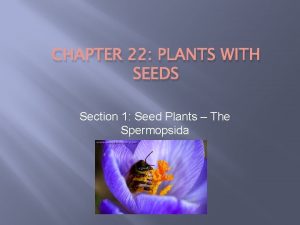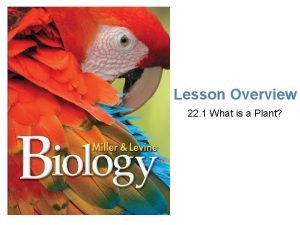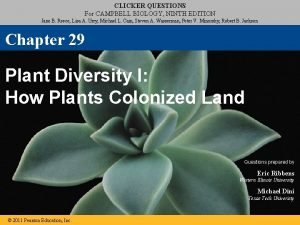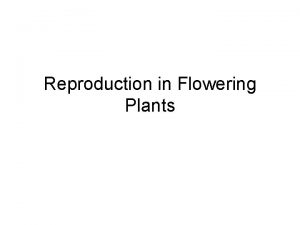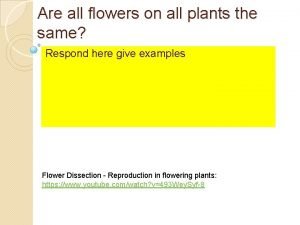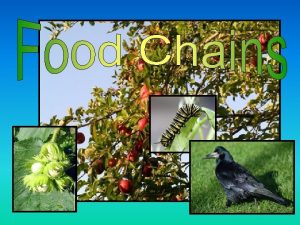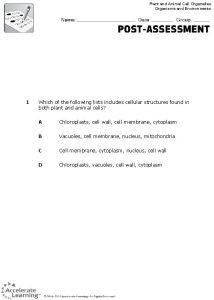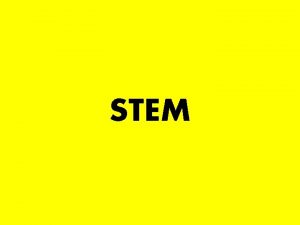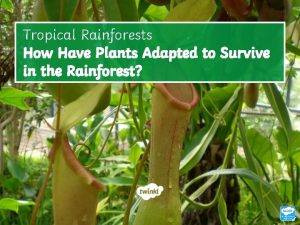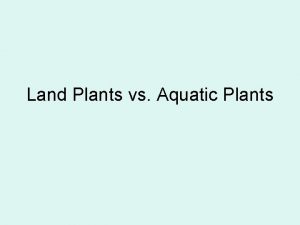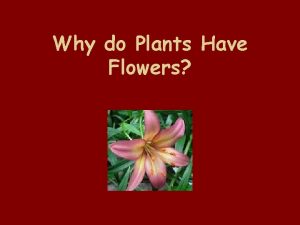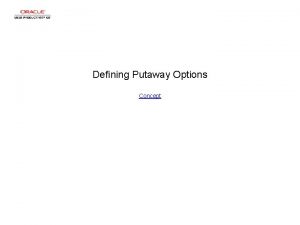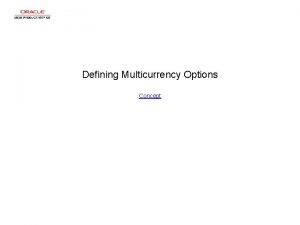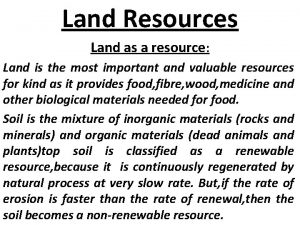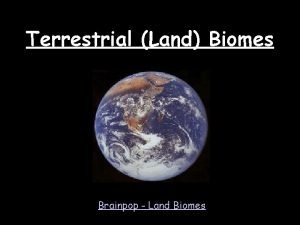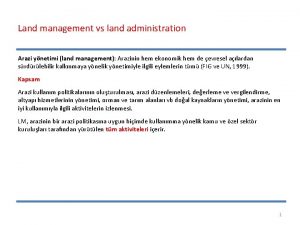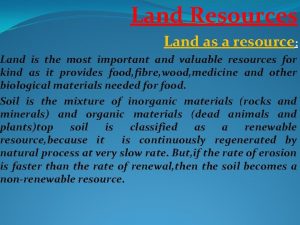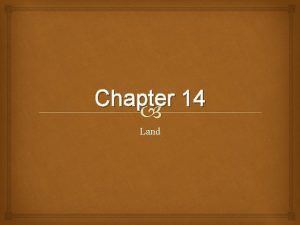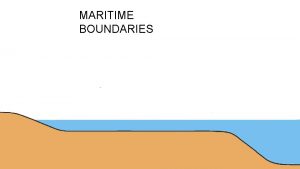Defining Plants 1 Defining Plants Land plants have



























- Slides: 27

Defining Plants 1

Defining Plants Land plants have two major features 1. Protected embryos 2. Multicellular haploid and diploid phases (In humans only the diploid stage is multicellular) 2

Defining Plants Adaptations to terrestrial life 1. Protection from desiccation by a waxy cuticle and stomata 2. Evolution of leaves which increase photosynthetic surface area 3. Shift to a dominant vertical diploid generation 3

Plant Life Cycles Alternation of Generations Plants have a haplodiplontic life cycle -Multicellular diploid stage = Sporophyte -Multicellular haploid stage = Gametophyte 4

5

Plant Life Cycles As more complex plants evolved: 1. Diploid stage became dominant 2. Gametophyte became limited in size 3. Sporophyte became nutritionally independent (photosynthetic) 6

Bryophytes are closest living descendants of first land plants -Called nontracheophytes because they lack tracheids (specialized transport cells) Simple, but highly adapted to diverse environments Non-photosynthetic sporophyte is nutritionally dependent on the gametophyte 7

Bryophytes Mosses (phylum Bryophyta) -Gametophytes- small, leaflike structures -Anchored to substrate by rhizoids -Sprophyte is nonphotosynthetic, dependent on gametophyte. 8

9

Features of Tracheophyte Plants Vascular tissues are of two types -Xylem – Conducts water and dissolved minerals -Phloem – Conducts sucrose and hormones -These enable height and size -Also characterized by the presence of a cuticle and stomata 10

Ferns Pterophytes -The most abundant group of seedless vascular plants with about 11, 000 species -The conspicuous sporophyte and much smaller gametophyte are both photosynthetic 11

The fern life cycle (differs from mosses) independence and dominance of the fern’s sporophyte Pterophytes 12

The Evolution of Seed Plants Seed plants first appeared 305 -465 MYA -Evolved from spore-bearing plants known as progymnosperms The seed represents an important advance 1. Protects the embryo 2. Easily dispersed 3. Introduces a dormant phase in the life cycle 13

The Evolution of Seed Plants Seed plants produce 2 kinds of gametophytes -Male gametophytes -Pollen grains -Dispersed by wind or a pollinator -Female gametophytes -Develop within an ovule -Enclosed within diploid sporophyte tissue 14

Gymnosperms are plants with “naked seeds” -Ovule is exposed on a scale at pollination There are four living groups All lack flowers and fruits of angiosperms 15

Gymnosperms Conifers (phylum Coniferophyta) are the largest gymnosperm phylum -Include: -Pines, spruces, firs, cedars and others -Coastal redwood – Tallest tree -Bristlecone pine – Oldest living tree Conifers are sources of important products -Timber, paper, resin and taxol (anti-cancer) 16

Gymnosperms Pines -More than 100 species, all in the Northern hemisphere -Produce tough needlelike leaves in clusters -Leaves have: 1. Thick cuticle and recessed stomata 2. Canals into which cells secrete resin 17

18

Angiosperms are the flowering plants -Ovules are enclosed in diploid tissue at the time of pollination -The carpel, a modified leaf that covers seeds, develops into fruit 19

Angiosperms Flower morphology -Outermost whorl = Sepals -Second whorl = Petals -Third whorl = Stamens (androecium) -Each stamen has a pollen-bearing anther and a filament (stalk) -Innermost whorl = Gynoecium -Consists of one or more carpels that house the female gametophyte 20

Angiosperms 21

Angiosperms Carpel structure -Three major regions -Ovary = Swollen base containing ovules -Later develops into a fruit -Stigma = Tip -Style = Neck or stalk 22

Angiosperm Life Cycle The female gametophyte (embryo sac) has 8 haploid nuclei arranged in two groups of four A nucleus from each group migrate toward the ovule’s center and become polar nuclei Cell walls form round remaining three nuclei -At the micropyle end, one cell functions as the egg, and the other two are synergids -At the other end, three cells are antipodals -They eventually break down 23

Angiosperm Life Cycle Pollination is the mechanical transfer of pollen from anther to stigma -Pollen grains develop a pollen tube that is guided to the embryo sac -One of the two pollen grain cells lags behind -This generative cell divides to produce two sperm cells 24

Angiosperm Life Cycle As the pollen tube enters the embryo sac, a double fertilization occurs -One sperm unites with egg to form the diploid zygote -Other sperm unites with the two polar nuclei to form the triploid endosperm -Provides nutrients to embryo When the seed germinates, a young sporophyte plant emerges 25

26

Angiosperm Life Cycle Angiosperms include: -Eudicots (about 175, 000 species) -Trees, shrubs, snapdragons, peas, other -Use flowers to attract insect pollinators -Monocots (about 65, 000 species) -Grasses, lilies, palms, irises, others -Some rely on wind for pollination Note: Self-pollination may also occur 27
 What is defining and non defining clause
What is defining and non defining clause Relative clauses defining and non defining
Relative clauses defining and non defining Defining and non defining relative clauses
Defining and non defining relative clauses Defining and non defining relative clauses in telugu
Defining and non defining relative clauses in telugu Relative clauses
Relative clauses Nonessential adjective clause
Nonessential adjective clause An area of land largely enclosed by higher land
An area of land largely enclosed by higher land A pointed piece of land extending into the sea
A pointed piece of land extending into the sea It has 5 faces 8 edges 5 vertices
It has 5 faces 8 edges 5 vertices Spermopsida plants
Spermopsida plants Life cycle of land plants
Life cycle of land plants The closest algal relatives of land plants are
The closest algal relatives of land plants are Vascular plants vs nonvascular plants
Vascular plants vs nonvascular plants Non vascular vs vascular plants
Non vascular vs vascular plants Characteristics of non-flowering plants
Characteristics of non-flowering plants Photosynthesis equation
Photosynthesis equation Hibiscus parts
Hibiscus parts Which seedless plants have been used to treat bee stings?
Which seedless plants have been used to treat bee stings? All plants have flowers
All plants have flowers Every living plants and animals must have
Every living plants and animals must have Plants have large round vacuoles they primarily use for
Plants have large round vacuoles they primarily use for What are herbaceous stems
What are herbaceous stems How have plants adapted to the rainforest
How have plants adapted to the rainforest Plants have different parts
Plants have different parts Why do plants have different parts
Why do plants have different parts Are plants multicellular eukaryotes
Are plants multicellular eukaryotes What part of the plant carries and protects the seed
What part of the plant carries and protects the seed Which seedless plants have been used to treat burns?
Which seedless plants have been used to treat burns?









